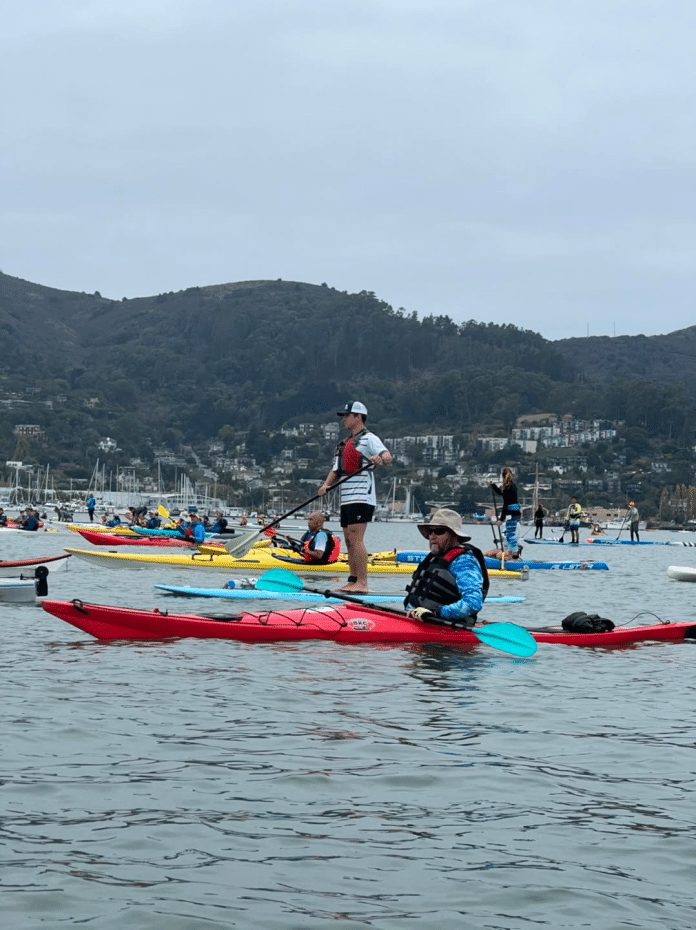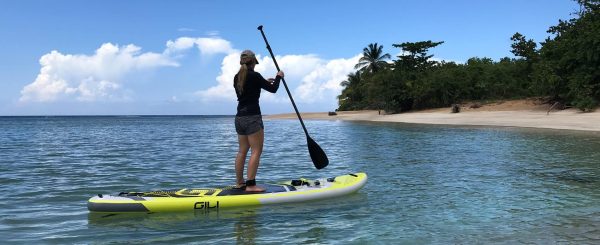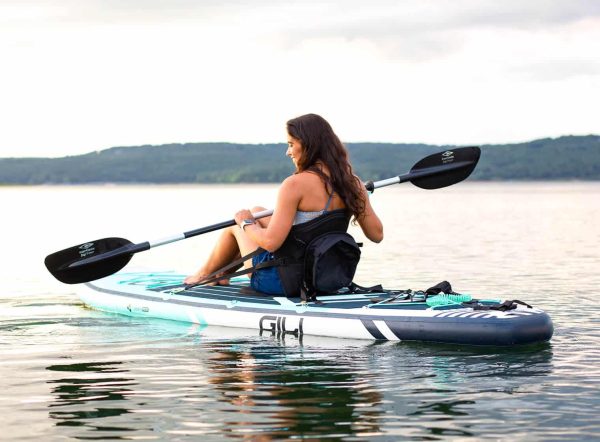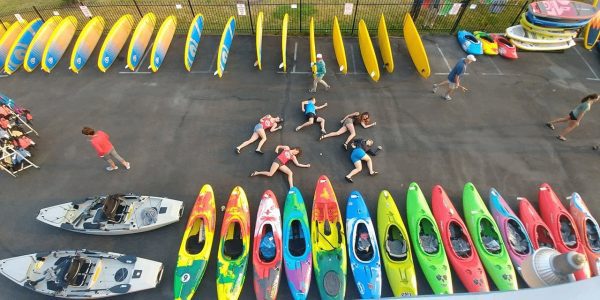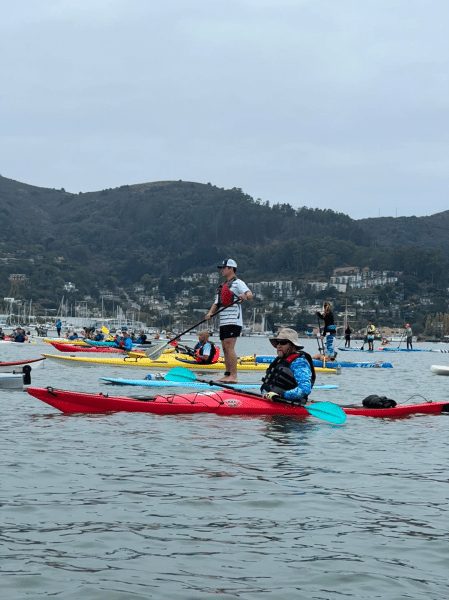We often find ourselves torn between the allure of gliding through the water on a stand-up paddleboard (SUP) and the sleekness of a kayak.
Both offer a unique and exhilarating experience, but the question remains: Which is faster?
To satisfy our curiosity, we took to the waves to compare the speeds of these two popular watercraft.
Read on as we uncover the truth behind the SUP and kayak rivalry and discover if one genuinely reigns supreme in the race against time.
Factors Affecting Speed
Several factors must be considered when comparing the speed of a stand-up paddleboard (SUP) and a kayak. These factors can significantly influence the speed and performance of each watercraft. Let’s explore the various elements that can affect the speed of an SUP or a kayak.
Hull Design
The hull design plays a crucial role in determining the speed of both an SUP and a kayak. A streamlined hull with a sharp bow and narrow body tends to reduce water resistance, allowing for faster movement through the water.
Many kayaks are designed with a V-shaped hull, which helps to cut through the water efficiently. On the other hand, SUPs generally have a flatter and broader hull, which provides stability but may not be as optimized for speed. The shape and design of the hull can significantly impact the overall performance of the watercraft.
Weight
Weight is another critical factor to consider when comparing the speed of an SUP and a kayak. In general, a lighter watercraft will have an advantage in speed.
This is because a lighter weight requires less effort to propel through the water, allowing for increased efficiency and speed. Kayaks are typically lighter than SUPs as they are designed for single-person use, whereas SUPs can accommodate more weight due to their larger size and broader functionality.
Length
The length of a watercraft is a crucial consideration for speed. Longer vessels tend to have more incredible hull speed, enabling them to glide through the water more efficiently. Longer kayaks can cover more distance per stroke, contributing to increased overall speed.
However, longer SUPs may require more effort to paddle and maneuver, impacting speed in specific scenarios. Finding the right balance between length and maneuverability is essential when considering the speed of an SUP or a kayak.
Width
Width is an often overlooked factor that can significantly affect the speed of a watercraft. In general, narrower kayaks and SUPs are faster than wider ones. A narrower width reduces resistance against the water, allowing for smoother and quicker movement. However, it’s important to note that narrower watercraft can also be less stable, especially for beginners or in rougher water conditions. Balancing speed with stability is crucial when choosing between an SUP and a kayak.
Stability
Stability is an essential aspect of any watercraft, as it directly affects the speed and confidence of the paddler. Kayaks are known for their inherent stability, thanks to their sit-in design and lower center of gravity. This stability can contribute to greater control and efficiency in paddling, enabling higher speeds.
On the other hand, SUPs offer a unique standing experience and provide a stable platform for various activities, but they may require more effort to maintain balance and stability. Understanding the stability requirements of your preferred water activities is crucial when assessing the speed potential of an SUP versus a kayak.
Paddling Technique
Apart from the inherent characteristics of the watercraft, the paddling technique also plays a vital role in determining speed. Both SUPs and kayaks require proper paddling techniques to maximize efficiency and speed. Let’s delve into the specific techniques for each watercraft.
SUP Paddling Technique
Stand-up paddleboarding utilizes a different paddling technique compared to Kayaking. To achieve maximum speed on an SUP, it is essential to maintain an upright posture while paddling.
This allows the paddler to generate more power and efficiency in each stroke. The technique involves extending the upper arm fully, catching the water with the paddle blade, and pulling it back through the water alongside the board. Proper rotation of the torso and engaging the core muscles can further enhance the paddling efficiency and speed. Mastering the SUP paddling technique can significantly impact the speed capabilities of the watercraft.
Kayaking Technique
The kayaking technique emphasizes using a proper stroke cadence and body movement to maximize speed. Efficient Kayaking involves maintaining a relaxed grip on the paddle and utilizing a torso-driven stroke. The kayaker should engage the core muscles and rotate the torso with each stroke to generate power.
Focusing on a consistent and rhythmic paddling motion helps maintain momentum and speed. Proper technique increases speed and reduces fatigue, allowing for longer and more efficient paddling sessions.
This image is the property of www.gilisports.com.
Speed Comparison
To compare the speed capabilities of an SUP and a kayak, it’s essential to consider different water conditions and specific activities. Let’s explore how each watercraft performs in various scenarios.
Flatwater Speed
Both SUPs and kayaks can reach impressive speeds in calm and flatwater conditions. However, due to their sleek and streamlined design, kayaks generally have a slight advantage in terms of speed.
The V-shaped hull and lower profile of a kayak contribute to reduced water resistance, allowing for faster gliding. SUPs, while not as streamlined, can still achieve respectable speeds with the proper technique and optimal design choices. In general, kayaks may have a slight edge over SUPs for flatwater speed-focused activities such as racing.
Open Water Speed
The speed advantage between an SUP and a kayak becomes less significant when it comes to open water, including lakes, bays, or coastal areas. The ability to adjust the paddling technique and adapt to varying water conditions plays a more significant role.
Both SUPs and kayaks offer versatile maneuverability in open water, allowing skilled paddlers to navigate efficiently and achieve comparable speeds. The choice between an SUP and a kayak in open water ultimately comes down to personal preference, comfort, and the specific activities one wishes to engage in.
Racing Speed
In competitive racing scenarios, where speed is paramount, kayaks are often favored due to their specialized design for speed and efficiency. Dedicated racing kayaks are typically longer, narrower, and more streamlined than recreational kayaks, allowing for higher speeds.
SUP racing has also gained popularity recently, with dedicated SUP race boards designed for maximum speed and performance. SUP racers often employ unique paddling techniques and specialized paddleboard designs to optimize speed. Nevertheless, in competitive racing, kayaks’ narrower and more hydrodynamic design generally provides an advantage in terms of pure speed.
Maneuverability and Agility
While speed is undoubtedly essential, maneuverability and agility are equally crucial considerations, especially for recreational paddlers. Let’s explore how SUPs and kayaks compare regarding maneuverability and agility.
Turning
Regarding turning abilities, kayaks offer greater agility due to their lower profile and sit-in design. The lower center of gravity and connection with the water allow kayakers to execute quick and precise turns.
Kayaks can easily maneuver through narrow channels, tight corners, and obstacles with relative ease. SUPs, on the other hand, require more effort and wider turns due to their larger size and standing position. However, paddleboarders can still achieve satisfactory turning abilities on an SUP with practice and skill development.
Navigating Obstacles
Both SUPs and kayaks excel in navigating obstacles, but each has unique advantages. With their lower profile and maneuverability, Kayaks can easily navigate rocks, logs, or other water obstacles. The ability to swiftly change direction and adjust paddle strokes allows kayakers to navigate tight spaces precisely.
SUPs, while larger and bulkier, offer stability and a better vantage point for spotting obstacles. The standing position on an SUP provides a clearer view of the water ahead, making it easier to steer clear of obstacles. Additionally, due to their shallower draft, SUPs are less likely to get lodged or stuck on submerged objects.
Surfing
Regarding catching waves and surfing, SUPs and kayaks offer different experiences. SUP surfing has gained popularity due to its stability and versatility on the waves. The standing position allows for better balance and control, making catching and riding waves easier.
Kayak surfing, on the other hand, requires excellent paddling technique and timing to catch and ride waves effectively. Both activities provide thrilling experiences, but choosing between SUP and kayak surfing depends on personal preference and skill level.
This image is the property of cdn.shopify.com.
Versatility
Versatility is a crucial factor to consider when choosing between an SUP and a kayak. One watercraft may offer more versatility depending on your preferred water activities and conditions.
Different Water Conditions
One of the advantages of an SUP is its versatility in various water conditions. SUPs can handle calm lakes, rivers, ocean bays, and small waves. An SUP’s standing position and stability suit leisurely paddling, yoga or fitness activities, fishing, and even touring longer distances. Some SUPs are specifically designed for surfing, allowing riders to catch and ride waves quickly. Kayaks, while versatile in their own right, are typically better suited for calmer waters and are excellent for fishing, touring, and exploration.
Transportation
Transportation is another aspect where SUPs have an advantage over kayaks. SUPs are generally lighter and easier to transport, especially inflatable SUPs, which can be deflated and packed into a backpack or car trunk.
This makes them more convenient for those who frequently travel or have limited storage space. Kayaks, while relatively easy to transport, require a roof rack or a trailer, as they are bulkier and heavier than SUPs.
Fishing and Recreation
SUPs and kayaks are popular for fishing and recreational activities on the water. A SUP’s stability SUP and standing position make attractive options for anglers who prefer a higher vantage point and more maneuverability.
SUPs also offer the ability to bring additional gear, such as coolers or fishing equipment, due to their larger size and weight-carrying capacity. On the other hand, Kayaks provide a comfortable and secure seating position, making them ideal for longer fishing trips. The sit-in design of a kayak offers better protection from wind and water splashes, enhancing the overall fishing experience.
Physical Effort
Engaging in paddlesports provides an excellent opportunity for physical exercise and a cardiovascular workout. Both SUPs and kayaks offer unique benefits regarding targeted muscle groups and overall fitness levels.
Muscle Groups
Paddling an SUP and a kayak engages different muscle groups, offering a well-rounded exercise. Kayaking predominantly targets the upper body muscles, including the arms, shoulders, and back muscles. The repetitive paddling motion helps strengthen these muscles and improve endurance.
SUPing, on the other hand, engages the upper body and the core muscles due to the standing position and the need for balance. Paddling while standing activates the leg muscles and the core, providing a complete workout for the entire body.
Cardiovascular Workout
Engaging in paddling sports, whether on an SUP or a kayak, provides an excellent cardiovascular workout. The continuous paddling elevates the heart rate, improving cardiovascular fitness and endurance.
Both activities offer low-impact exercises suitable for individuals of various fitness levels. Depending on the intensity and duration of the paddling session, one can achieve an effective cardiovascular workout while enjoying the beauty of the water and nature.
This image is the property of images. Surfers. Art.
Fitness and Skill Level
When considering the speed of a SUP versus a kayak, fitness level and skill play an important role. Let’s explore how these factors can impact the performance of each watercraft.
Experience Level
For beginners or less experienced paddlers, kayaking often provides a more user-friendly introduction to paddle sports. The sit-in design and lower center of gravity offer excellent stability and control, making it easier to master basic paddling techniques. SUPs, while beginner-friendly, may require a bit more initial balance and coordination. However, with practice and skill development, both beginners and experienced paddlers can achieve comparable speeds and performance on an SUP or a kayak.
Fitness Level
While fitness level is not a limiting factor for enjoying paddling sports, it can influence the speed and endurance of an individual. With its primarily upper body focus, Kayaking requires strong arm and shoulder muscles for efficient paddling.
SUPing, on the other hand, engages more muscles, including the core and legs, which may be more demanding for individuals with lower fitness levels. However, both activities can improve fitness and strength with regular practice, regardless of initial fitness level.
Personal Preference
Ultimately, choosing between an SUP and a kayak comes down to personal preference, intended use, and individual goals. Some individuals may prioritize speed and efficiency, opting for a sleek, streamlined kayak design.
Others may prefer the versatility and stability of an SUP, allowing for various activities such as recreational paddling, fishing, and even yoga. Engaging in demos and trying out different watercraft is the best way to determine personal preference and find the perfect fit for your paddling needs.
This image is the property of images. Surfers. Art.
Conclusion
Several factors come into play when comparing the speed of an SUP and a kayak. The hull design, weight, length, width, stability, and personal skill level all contribute to the overall performance of each watercraft.
While kayaks generally have a slight speed advantage, SUPs make up for it in terms of versatility, maneuverability, and overall enjoyment. Both paddle sports offer unique experiences and numerous benefits, making them enjoyable activities for individuals of all ages and fitness levels.
Whether you prefer the speed and agility of a kayak or the stability and versatility of an SUP, getting out on the water and exploring the world of paddling is an adventure worth undertaking.

